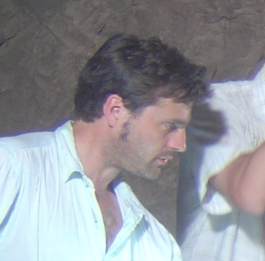Gilded Age
Cairo’s mega- projects of new concrete push ever further into the surrounding desert relegating the colonial era downtown to a traffic encircled, smog enshrouded, dusty artifact, though it still sports a spectacular collection of European architecture. Countless beaux art, art nouveaux and art deco facades line the avenues. But all the beautifully articulated, complex ornamentation has an unintended consequence of trapping the airborne dust of the desert giving the downtown an aged but otherwise timeless embalmment.
The majority of windows in upper floors are never opened- to keep dust out and consequently the city center is dark above street level. The facades are eerily lit from below by the bustling street, or glow in color from huge neon billboards atop the buildings. The lighting’s mood is one which western eyes readily associate with Ridley Scott’s cinematic vision in Blade Runner- sans rain. The combination of that futuristic conception, mixed with the European architectural time capsule in a Middle Eastern city is disruptive of clearly discernible temporality.
One day as I walked past a darkened art supply store I noticed a wall of green drawers all ajar adjacent to the front door. There was a measurably thick layer of the incessant
I slowly pulled drawers open and could make out their deeper contents only slightly dusted: rows of rock hard paint tubes, baked enamel palettes stamped from tin, ink bottles with a dried nub of color rattling inside, other bottles still liquid but sealed by a glob of wax, sheaves of yellowed paper. It was peering into the first half of the 20th century. I fancied parasol-toting visitors over the years outfitting themselves to sketch the monuments, perhaps pith helmeted soldiers of empire heading letters with a flourish of color. Amidst the scatter, a corner of gold was eye-catching. A row of small metallic paper envelopes emerged from powdery cocoons and I pulled one out. It was the size of a matchbox and wrapped awkwardly around its contents. The front read “Illuminating Water Colour- Fine Gold”; below a Winsor & Newton logo.
The owner was uninterested in my “find”. He knew he couldn’t sell it to current customers. Apparently he enjoyed my protracted search and repeated, amazed extractions, for he refused any money, happy that I seemed happy with my little envelope. As I wandered off, I wondered if this antique paint had value for containing any real gold, who knows? But I certainly was not expecting what I later found.
Sitting on a hostel balcony, Corinthian capitals flaking at my back, I carefully pealed open the envelope. Into my hand plopped a mussel shell- blue and iridescent. Turning it over- revealing smooth mother of pearl on the inside, a dried smear of gold clung to one rim. Years later I learned illuminating paint is still called “shell gold” because it was once sold this way.
We live in an era where containers are as common as products. Centuries ago someone solved the pigment packaging issue with natural containers that are free and inert. Modern materials with the advantage of flexibility are now readily available and have supplanted shells. Is the mussel shell an anachronism or is it possible that one day they will be used again? Not as a return to some imagined utopian past;
By chance I worked with the now elderly manufacturer who figured out how to mass produce the famous Cabbage Patch dolls where “no two dolls are alike”. Here difference and variation were reintroduced as an added value a century after mass production had abolished it. But the insidious thing in this example is that difference was simply a plurality of locations on a grid and millions of fixed points rather than movement, unpredictability and gradation. The mussel shell brings variation as a true continuum. But why stop at the mussel shell as a container- what about a mussel shell in one instance, an old bottle cap in the next envelope and a ferret’s cranium in the package after that.


0 Comments:
Post a Comment
<< Home